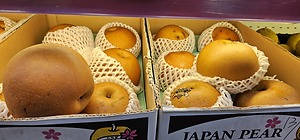


Cho Juro Asian Pears
Estimated Inventory, lb : 0
Description/Taste
Chojuro pears are medium to large fruits, averaging 6 to 7 centimeters in diameter, and have a round, ovate, to slightly flattened, lopsided shape. The skin is firm, semi-thick, chewy, and russeted, ripening to golden-bronze, and covered in pale lenticels. The skin is also easily bruised, and when scratched, the mark discolors to a black, dark brown hue. Underneath the surface, the flesh is cream-colored, coarse, lightly juicy, and crisp with a soft snap-like quality, encasing a small central core with black-brown seeds. It is important to note that the fruit's texture will vary each season, depending on growing conditions, and will range from gritty to faintly coarse. Chojuro pears have high sugar content with low acidity, developing a mild and sweet flavor with subtle notes of butterscotch and rum.
Seasons/Availability
Chojuro pears are available in the mid-fall through winter.
Current Facts
Chojuro pears, botanically classified as Pyrus pyrifolia, are a Japanese heirloom variety belonging to the Rosaceae family. The early to mid-season fruits were among the first Japanese russet pears introduced for cultivation into California and were favored among growers for its extended storage capabilities, sweet flavor, and productive nature. Chojuro pears were also extensively cultivated in Japan in the early 20th century, and the name Chojuro roughly translates to mean “plentiful.” In both California and Japan, Chojuro pears were eventually replaced by newer, modern varieties with improved texture, taste, and growth characteristics. Chojuro pears were also notoriously known for their gritty flesh and delicate skin, easily marked or bruised, making it difficult to compete with other, more aesthetically pleasing, varieties in commercial markets. In the modern-day, Chojuro pears are challenging to find in large quantitates, but the variety is still grown on a small scale through pear enthusiasts and heirloom farms.
Nutritional Value
Chojuro pears are an excellent source of fiber to regulate the digestive tract and are a good source of vitamin C to strengthen the immune system. The fruits also contain potassium to balance fluid levels within the body and provide lower amounts of copper, vitamin K, folate, magnesium, and phosphorus.
Applications
Chojuro pears are best suited for fresh applications as their sweet, aromatic nature is showcased when consumed straight, out-of-hand. The pears can be eaten with the skin on or off and are frequently sliced and displayed on fruit platters, chopped and tossed into salads, or quartered and consumed as a healthy dessert. Chojuro pears can also be drizzled in chocolate and caramel, grated into coleslaw, or juiced and used to flavor beverages. In addition to fresh applications, Chojuro pears can be incorporated into baked goods such as pies, cakes, muffins, and tarts, blended into sorbets, poached in sweet syrups, or braised in wine. They can also be cooked into sauces for savory dishes, baked into risotto and creamy casseroles, or canned and preserved for extended use. Chojuro pears complement ingredients, including meats such as pork, poultry, beef, and fish, spices such as cinnamon, allspice, ginger, and nutmeg, vanilla, honey, shiso, daikon radish, cashews, kale, and fennel. Whole, unwashed Chojuro pears will keep 1 to 5 months when stored in the refrigerator.
Ethnic/Cultural Info
Nashi No Hi is an alternative holiday in Japan centered around the Asian pear. The fruit-filled celebration is annually held on the 4th of July, or 7/4, as the words for seven and four in Japanese, “nana” and “shi,” sound like “nashi,” the term for pear. While the holiday is not a national event where Japanese citizens receive time off from work, many families take a moment throughout the day to reflect and honor the significance of Asian pears within Japanese history. Asian pears are also celebrated by being eaten, and the fruits are consumed fresh or incorporated into baked goods and sweets. In Kawasaki City, the Chojuro pear’s original home, there is a stone monument known as “Tanashi Remains” in the Kawasaki Daishi Heimaji Temple that is dedicated to Mr. Tatsujiro Toma for his achievements in pear cultivation. On July 4th, the monument is sometimes decorated with flowers or Chojuro pears in memory of the famous breeder.
Geography/History
Chojuro pears were discovered growing as a chance seedling in the orchard of Mr. Tatsujiro Toma in 1895 in Kawasaki, Japan. The parent varieties of Chojuro pears are unknown, and the cultivar was named after the Toma family house. Once introduced to local Japanese markets, Chojuro pears widely increased in popularity for cultivation, especially during a scab pandemic in the late 1890s as the variety was one of the few pears somewhat resistant to the disease. Farmers across Japan planted Chojuro pears, and at one time, the cultivar accounted for approximately 80% of pear cultivation within the country. Despite the fruit’s established reputation, Chojuro pears eventually declined in popularity during the 1950s as modern pear varieties replaced the old cultivar to meet changing consumer demands. Chojuro pears were also introduced and planted in California in 1939 and Australia in 1980 for cultivation. Today Chojuro pears are cultivated on a small scale in Akita, Aomori, and Miyagi Prefectures in Japan and are also grown through select farms in the United States and Australia.
Recipe Ideas
Recipes that include Cho Juro Asian Pears. One
| Vegetarian Times |
|
Wilted Spinach Salad with Asian Pears, Blue Cheese, and Pecans |
| Vegetarian Times |
|
Asian Pear and Avocado Bowl |
| Vegetarian Times |
|
Yellow Beet and Asian Pear Salad |
Podcasts














